
It seems appropriate that the first Japanese RPG I write about was also one of the first made in Japanー Sword World (ソード・ワールド). Sword World first caught my eye a few years ago, but I never had a chance to play it until I mentioned my interest to a friend and he offered to run a session.
My friend hadn’t played it in a long time, so he graciously picked up the Sword World 2.0 Starter Set (Japanese) and gathered together four additional players. We ran through the entire box set in an afternoon at a games play space in Ikebukuro called Naruneko House (Japanese).
A World of Swords
The original Sword World takes place in Forcelia, the same world as Record of Lodoss War, but Sword World 2 takes place in Raxia. It’s a world that was formed by three magical swords (corresponding roughly to good, evil, and neutrality) long ago. These sword created the world and people, some of whom became gods by taking on the power of the swords.
The Starter Set
The start set contains a number of cardboard game pieces; cards; health and mana counters; six sided dice; a GM screen; and two short books (one for rules, one for the story). The quality was quite high, and one thing that surprised me is that the starter set is made to be play without pencil or paper. I found the artwork a nice anime style that fit the game well. The box itself is heavy duty cardboard similar to a board game box.
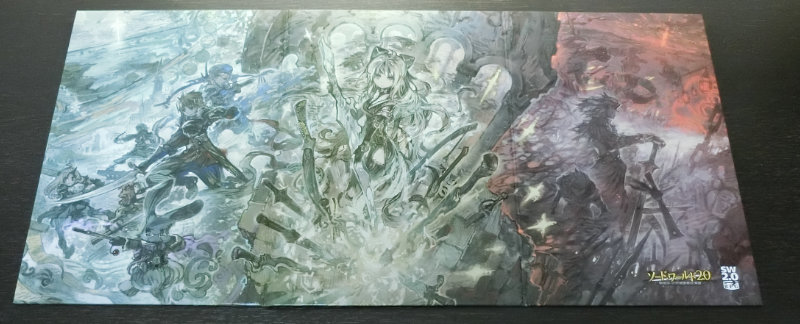

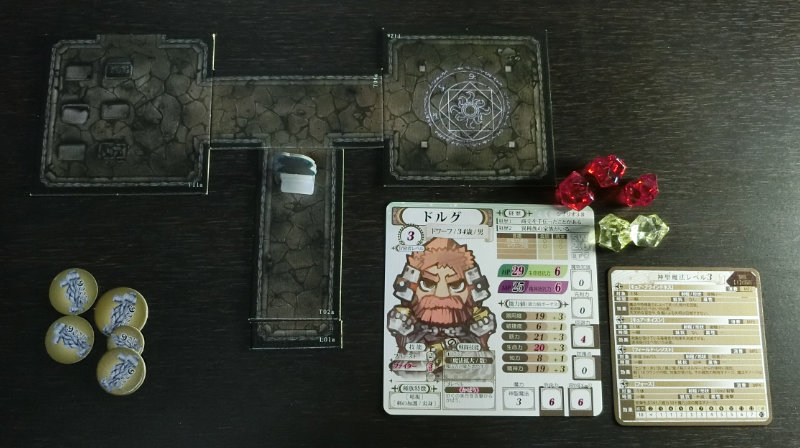
All bookkeeping is abstracted away through cards or counters, and characters are leveled up by choosing one of two new character sheets for each level. Overall, I was very impressed by the contents and their quality. The character sheets and equipment, for example, are designed so that the attributes they affect line up, which makes calculating the current value easy.
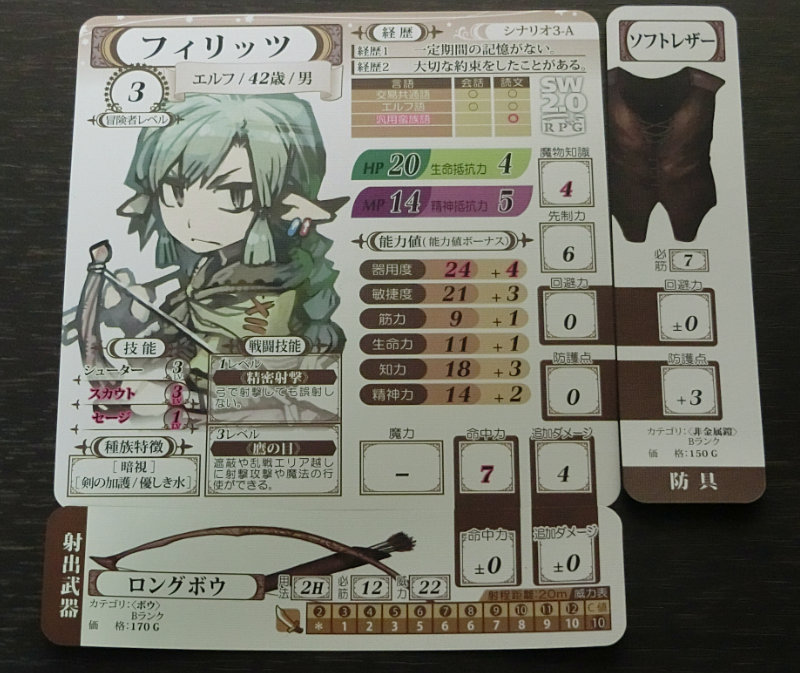
The pre-made characters are a mix of common fantasy tropes along with those unique to Sword World characters as well. Each character has one or two plot hooks and a background to tie them to the others. For example, I played an Elven ranger who had amnesia and is looking for a lost fiend. All of the character’s stats, skills, abilities, equipment, and background are printed on the two-sided character card, with the mechanical values being on the front and the character details on the back.

Cardboard character and monster tokens are provided with stands that can be used on the battle map. There is also a party token that is used on the overland and dungeon tiles. Monsters are also provided with illustrated cards and tokens, with their stats printed on the backside.
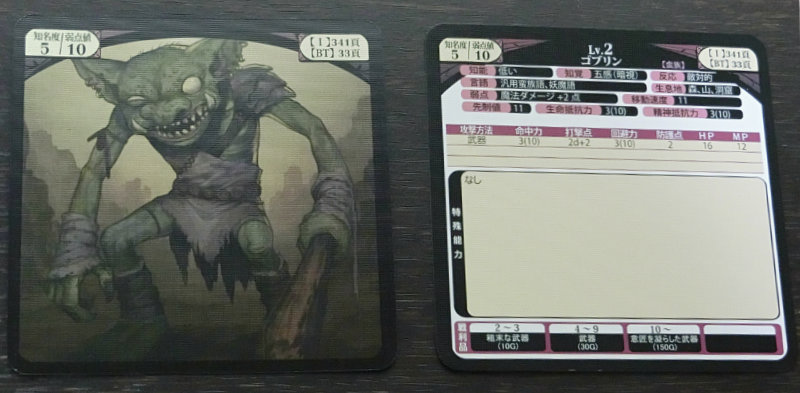
The System
The rules used in the starter set are a simplified version of those in the core rulebook, and I found them to flow fairly smoothly. As one of the players described, the system is a mix of D&D and RuneQuest, and it had an immediate feeling of nostalgia for me despite having never played it before. It definitely felt like a modernized take on a classic system.
Sword World is a hybrid class-skill system. Character level, which brings increased health and magic, is determined by the highest level skill. This has the nice effect of enabling both generalist and specialist characters to coexist. Skills are fairly broad, being closer to professions in other RPGs. For example, the ranger-like character I played had shooter, scout, and sage skills. The six attributes (agility, dexterity, strength, life, intelligence, and spirit) are combined with skills depending upon the action being performed. Covering one’s tracks uses the agility attribute with the scout or ranger skill, while moving stealthily uses dexterity with one of those skills.
At its core, it uses 2D6 to resolve all actions. Characters with a relevant skill will add their attribute and skill to the roll. Characters without the required skill use the unmodified roll. If the resulting number is equal to or greater than the target number, the check succeeds. Rolling two sixes is an automatic success and rolling two ones is an automatic failure, but an automatic failure nets the player 50 experience points. Resources used during the check are consumed regardless of the result.
For opposed rolls, the player with the highest result wins. Draws are resolved so that the success is shared fairly (such as a race resulting in a dead heat) unless a clear winner is required. In that case, the players that tied make the same check again until there is a clear winner.
Combat
Players often roll against tables, specifically for damage, healing, and casting spells to determine how effective their action was. An interesting aspect is that the to-hit role and damage rolls are separate, with the possibility of a hit not dealing damage. Additionally, the game simulates evasion and absorption by giving each character and piece of armor evasion and protection values. For example, a shield gives 1 evasion, while soft leathers give 3 protection. When rolling to defend, the evasion value is added to the roll, and if hit, the protection value is subtracted from the damage. Damage itself is determined by rolling 2d6 and comparing the result to the damage table for the weapon being used.
Each weapon has a different table of values and a different target for a critical. If a critical is scored, damage is rolled again and added to the previous damage. The weapon and spell cards that come in the starter set made it easy to calculate damage. Healing is likewise determined by rolling on the table listed on the spell card.

Combat evoked the feeling of early Final Fantasy games. Combat takes place on a large tile divided into three sections: player rear, melee area, and enemy line. There is a set distance between each line, and characters can move between them if the enemy is not in their current section. When players and enemies are in the same area, it becomes a melee battle and ranged attacks have a chance of hitting allies. Certain abilities, such as one of the Elven perks, allows them to fire into the melee without penalty and at higher levels the ability to fire upon the enemy backline. Characters in the same space can attack any other character in that space. I found this simplified range system an elegant mix between theatre of the mind and full on miniature combat.
When combat begins, each side rolls to see if the players or the enemies have initiative. Once decided, the players can decide the order they go in, which can change each round. Once one side is finished, the other side goes. Attacks use an opposed roll system, with both the attacker and defender comparing their rolls to see if the attack hits. Boss monsters always make these rolls, but minions have a static target number to help speed combat along.
Both health and mana are point systems tracked by the red and yellow counters, respectively. Mana is easier to restore than health.
Language
It’s hard for me to objectively grade the difficulty of the Japanese, but the text was clear and fairly easy to understand. In terms of formatting, the text was nicely spaced and not cramped. The copious use of diagrams and charts also made it easy to confirm one’s understanding.
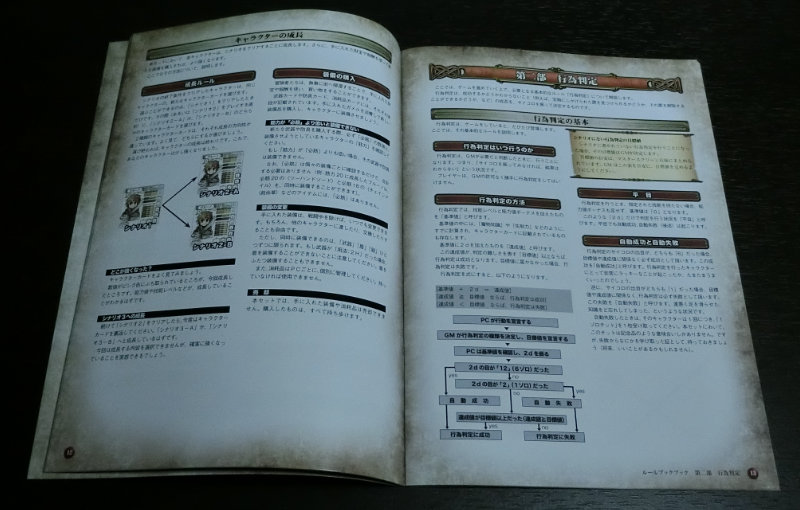
I generally find flavor text harder to read than rules, so am including both types of excerpts to show the type of language used:
Sample Rules Text
弓矢などの、射程距離を持つ攻撃は射撃攻撃と総称されます。その射程距離で、攻撃できる対象(エリア)が規定されます。 – Rule Book, page 21
Attacks that have a range, such as bows and arrows, are collectively called shooting attacks. The area that can be attacked is determined by the attack’s range.
Sample Flavor Text
フィリッツは冒険好きで、友人とよく遺跡探索をしていました。ところがある魔剣の迷宮に挑んだ時、魔法の罠にかかって気絶してしまいます。目覚めると迷宮はもぬけの殻。魔剣も友人も見当たりません。 – Ranger Character Card
Fritz loved adventuring and often explored ruins with his friend. They delved into a Magic Sword’s labyrinth, but were caught in a magical trap. When he awoke, the labyrinth was deserted. Neither the magical sword nor his friend were to be found.
Conclusion
The starter set was of impressive quality and the tiles and counters could easily be used in continued games. Coming in as an old hand to RPGs, but a first time Sword World player, I found it easy to get my bearings and learn the system as new aspects came up.
The system itself has a modernized crunch to it that was really quite fun. I would definitely play again if I have the chance.
| Sword World 2.0 Starter Set | |
|---|---|
| Publisher | Group SNE |
| Product Page | Publisher Site |
| Online Retailer | Amazon Japan |
| Released | 2015-8-8 |

I picked up this set since it seemed a good introduction for people new to TRPGs as well as being more accessible for japanese friends (the GM screen is also a huge bonus).
However I need to get more familiar in order to run it effectively and this is a great review/summary to help orient me.
Thanks for the in-depth analysis and clear pictures to show what the set provides!
Have you tried any subsequent one-off sessions or campaigns and were there any issues that you noticed?
Thank you for your kind words. I’m so glad this post was helpful!
That’s really cool that you picked up the set. I’d love to hear about your experiences as you prepare and run it.
I unfortunately haven’t played any subsequent games of Sword World. I vaguely recall us being a bit surprised about the skill placement on two characters in the starter set. One character was better at a skill than another character that would have been the “obvious” choice, but I don’t remember which skills/characters. It was very minor, but the characters switched roles once we noticed that. I think it was related to exploration and not combat.
In terms of a campaign, the starter set will take the characters up to level 3, sp once you finish the starter box content you might want to pick up the first core rulebook, which will take them to level six. It appears that Rulebook 2 goes to level 10, and book 3 will take them to level 15.
One a side note, Sword World 2.5 is now out. It’s a refinement of the 2.0 system that the starter set is based on, but has the same fundamentals, so I think the starter set will still be a good gateway. Taking a random spell as an example, the stats are exactly the same, with just some changing to the wording to make it clearer.
I just remembered that there is also an expansion to the Starter Set that includes two new characters (a Fairy Tamer and Shadow Grappler), new tiles, tokens, and three scenarios. There’s also apparently a solo adventure as well.
I have been looking into getting into this. The only problem is I can’t read or speak Japanese. I would love for this to be translated into English.
Yeah, it’d be neat if it got translated. There’s a new “building box” starter set that moves it a bit more towards a board game, with characters being easily customized by combining different character templates. Thinking about picking it up, and if I do, I’ll make a post about it. Thanks for your comment! 🙂